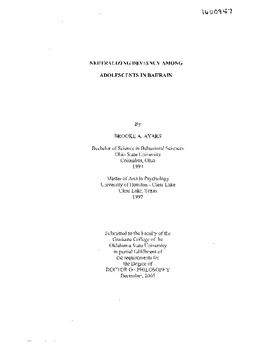| dc.contributor.advisor | Hynson, Lawerence M., Jr. | |
| dc.contributor.author | Ayars, Brooke A. | |
| dc.date.accessioned | 2016-07-18T15:48:07Z | |
| dc.date.available | 2016-07-18T15:48:07Z | |
| dc.date.issued | 2005-12 | |
| dc.identifier.uri | https://hdl.handle.net/11244/44061 | |
| dc.description.abstract | Scope and Method of Study: The purpose of this one-year research study was to discover how Bahraini youth interpret and identify the meaning of deviancy and to test empirically the theory of neutralization. Two of the three research questions focused on comparing the original neutralizations (Sykes and Matza 1957) to the recent neutralizations (Klockars 1979; Minor 1981; and Coleman 1981 ). The 227 students who participated in the study were conveniently sampled at a private school in Bahrain (Middle East) where the primary investigator was employed as the middle school principal. Each participant completed the Agreement to Neutralization Survey and 196 students participated in informal discussion groups. The investigator was interested in the social construction of deviancy, agreement to moral absolutes and neutralizations, and reported deviant behaviors. | |
| dc.description.abstract | Findings and Conclusions: It was discovered that Bahraini youth identify deviance as those individuals who are socially bad, do bad things and break social rules, and are abnormal. They provided the following as primary examples of deviant behaviors: disrespecting people, fighting, stealing, drinking alcohol, and vandalizing. And, when comparing the original neutralizations to the recent neutralizations, the research revealed that a greater percentage of students who adhere to moral absolutes reported endorsing the original neutralizations, particularly Denial of Responsibility (34%), more than the recent neutralizations. On the other hand, the findings showed a significant relationship existed between the employment of recent neutralizations, particularly Entitlement, and the commission of deviant acts for those students who agreed to the moral absolutes. And finally, the reliability test found the most reliable measures, drinking, fighting, cheating, and bullying, are most supportive of neutralization theory. | |
| dc.format | application/pdf | |
| dc.language | en_US | |
| dc.rights | Copyright is held by the author who has granted the Oklahoma State University Library the non-exclusive right to share this material in its institutional repository. Contact Digital Library Services at lib-dls@okstate.edu or 405-744-9161 for the permission policy on the use, reproduction or distribution of this material. | |
| dc.title | Neutralizing deviancy among adolescents in Bahrain | |
| dc.contributor.committeeMember | Dodder, Richard A. | |
| dc.contributor.committeeMember | Johnson, "Deke" | |
| osu.filename | Thesis-2005D-A973n.pdf | |
| osu.accesstype | Open Access | |
| dc.type.genre | Dissertation | |
| dc.type.material | Text | |
| thesis.degree.discipline | Sociology | |
| thesis.degree.grantor | Oklahoma State University | |
